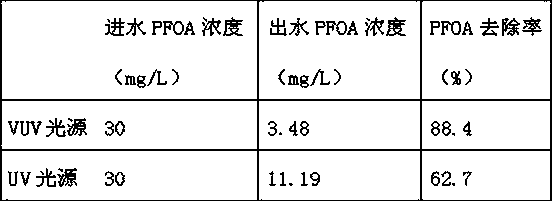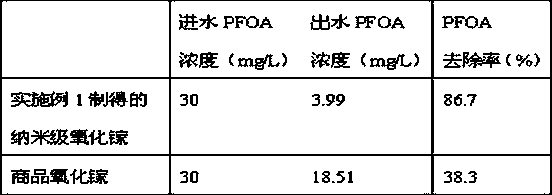Method for nano-scale gallium oxide vacuum-ultraviolet photocatalytic degradation of perfluorooctanic acid
A technology of vacuum ultraviolet light and perfluorooctanoic acid, which is applied in the field of water treatment, can solve the problems of reduced catalyst activity, high price of precious metals, and difficulty in popularization and use, and achieves the effects of improving conversion efficiency, reducing preparation cost and improving efficiency.
- Summary
- Abstract
- Description
- Claims
- Application Information
AI Technical Summary
Problems solved by technology
Method used
Image
Examples
Embodiment 1
[0028] 1) Mix water and ethylenediamine at a volume ratio of 50:1, add gallium nitrate to the above mixture to prepare a 0.2mol / L gallium nitrate solution, and adjust the pH to 9.5 with ammonia water;
[0029] 2) Put the above liquid in a hydrothermal reaction kettle, seal it, place it in a constant temperature drying oven, heat it at 180°C, and react for 3 hours, take out the reaction kettle and cool it to room temperature, centrifuge the product in the reaction kettle to obtain a precipitate, and use After washing with deionized water, the resulting precipitate was dried in an oven at 60 °C for 4 h to obtain nano-sized β-Ga 2 o 3 Precursor spare;
[0030] 3) Put the above precursors in a muffle furnace, raise the temperature to 800°C at a rate of 2°C / min under a nitrogen atmosphere, and roast at a constant temperature for 3 hours to obtain nano-sized β-Ga 2 o 3 Materials, the materials are self-made nano-scale gallium oxide photocatalysts after being ground through a 400-...
Embodiment 2
[0036]1) Mix water and ethylenediamine at a volume ratio of 40:1, add gallium nitrate to the above mixture to prepare a 0.25mol / L gallium nitrate solution, and adjust the pH to 9.0 with ammonia water;
[0037] 2) Put the above liquid in a hydrothermal reaction kettle, seal it, place it in a constant temperature drying oven, heat it at 200°C, and react for 2 hours, take out the reaction kettle and cool it to room temperature, centrifuge the product in the reaction kettle to obtain a precipitate, and use After washing with deionized water, the resulting precipitate was dried in an oven at 70 °C for 3 h to obtain nano-sized β-Ga 2 o 3 Precursor spare;
[0038] 3) Put the above precursors in a muffle furnace, raise the temperature to 900°C at a rate of 3°C / min under a nitrogen atmosphere, and roast at a constant temperature for 3 hours to obtain nano-sized β-Ga 2 o 3 Materials, the materials are self-made nano-scale gallium oxide photocatalysts after being ground through a 400-...
PUM
 Login to View More
Login to View More Abstract
Description
Claims
Application Information
 Login to View More
Login to View More - Generate Ideas
- Intellectual Property
- Life Sciences
- Materials
- Tech Scout
- Unparalleled Data Quality
- Higher Quality Content
- 60% Fewer Hallucinations
Browse by: Latest US Patents, China's latest patents, Technical Efficacy Thesaurus, Application Domain, Technology Topic, Popular Technical Reports.
© 2025 PatSnap. All rights reserved.Legal|Privacy policy|Modern Slavery Act Transparency Statement|Sitemap|About US| Contact US: help@patsnap.com


